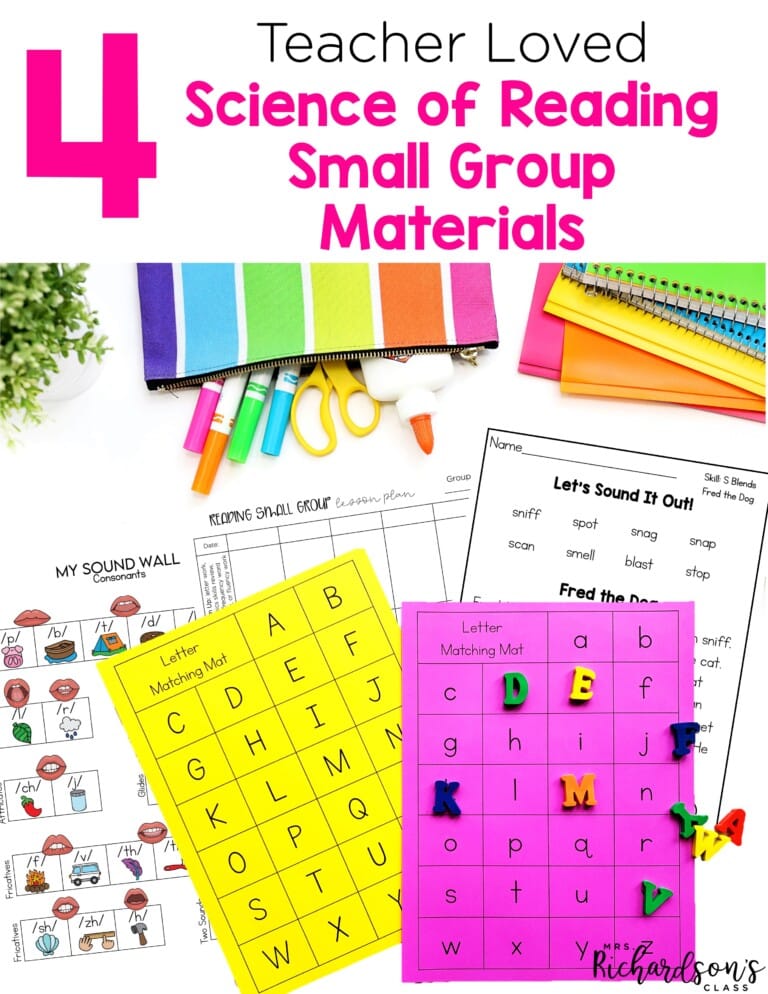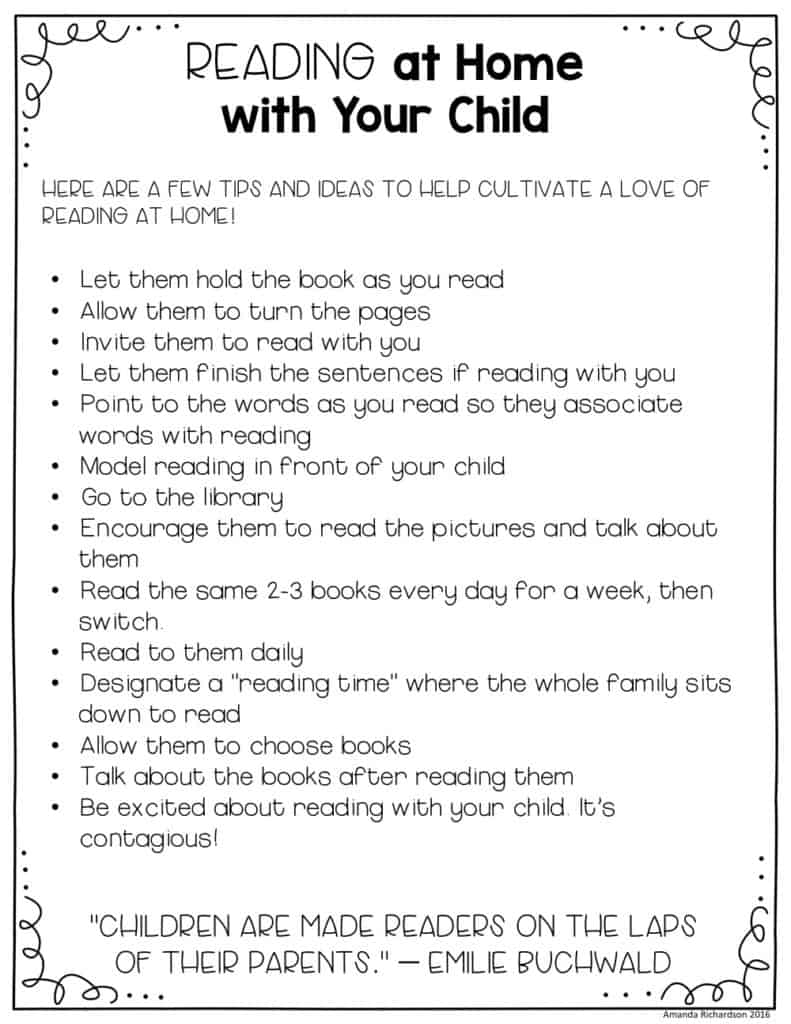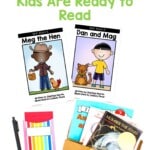

One common misconception about guided reading is that you can’t start until kids know all of their letters, sounds, and sight words and are ready to read. But, how do you know when kids are ready to read? Is it when they know all of their letters? Or are they ready when they can name all of the sounds letters make? Sometimes it can feel overwhelming to figure this out and start kids reading at just the “perfect” time.
I think you might be surprised to learn that kids might be ready to read sooner than you think. While it’s so important to keep our students’ learning developmentally appropriate, it’s also important to make sure we are encouraging our students to move forward as they are ready.
When students start showing an interest in books and reading, they are probably ready to start learning! An interest in reading might look like students seeking out particular books or topics and ask for help finding them.
They might ask you “What does this say?” when they are looking through books. You might see them start to focus on the illustrations and try to figure out what is going on in the book. These are all signs students might be ready to learn how to read.

What can you do if students are at the age where they should have an interest in reading, but they don’t? You can help cultivate a love for reading in them. Some students may not have had experiences with books for a multitude of reasons.
To help students learn to enjoy reading and show an interest in books, you can try to surround them with exciting literature, be a joyful example, and give them positive experiences.
Understanding concepts of print is one of the foundational skills of reading. When our youngest readers grasp these, they will be more ready to learn how to read.
Concepts about print include many important skills like:
Because grasping concepts about print is so important for knowing when kids are ready to read, I have a whole blog post dedicated to this topic. Check it out HERE! It covers more concepts, how to model them, and when you can teach them throughout the day.
Readers don’t have to have all of these down to begin reading – just enough that they understand how to open a book, know what they are looking at when they see text, and how to move their eyes/finger throughout the book. They will learn more and more concepts of print as they practice reading!
Being ready to read happens when students have a strong understanding of two things – concepts of print and phonemic awareness. Phonemic awareness is the ability to hear and manipulate phonemes.
Phonemic awareness does NOT include letter identification or matching letters to their sounds. It focuses ONLY on the phonemes.
Some of these areas of focus include:
When students are comfortable with the basics of phonemic awareness, they are definitely ready to begin learning how to read.
If you think you have some students who need to practice with some phonemic awareness activities, check out THIS POST. You can squeeze in phonemic awareness activities throughout the day. It could be in shared reading, through songs, or as a quick whole group.
Many times teachers and parents think that students must master all of their letters and sounds to be ready to read. The reality is that only a few are needed to start building words and reading them.
As long as a student knows enough letters to create a few words, they will be able to read at least a few texts. M, S, T, and A are a great place to begin.
The other misconception is that they must be able to read all high-frequency words. Knowing just a few basic ones is enough to get them started! “A”, “the”, and “can” are great ones to get started with.
Joining a few known letters, sounds, and high-frequency words together makes reading possible! It’s important to not pass up this opportunity to give a student a text, no matter how simple you may think it is. Placing a book in their hands places power in their hands–they feel successful!
Even if students are not reading at all, you can still meet with them during guided reading to intentionally move them forward. Jan Richardson suggests focusing on four areas for these students:
Before I learned about her technique, I basically was doing this same thing on my own. It worked really well! I created a whole post on Guided Reading with Non-Readers to walk you through the whole lesson. I shared what I say, activities to do at the table, and what the lesson cycle looks like.
Now that you know what to look for when judging if kids are ready to read, let’s jump into where to start. Most young readers will begin on guided reading level A. On this level, students will focus on:
Because the guided reading lesson structure includes an introduction, you’ll be able to set students up for success in reading. During word work and the introduction, you can have students practice the sight words from the book and introduce important words they’ll need to know. Give them the tools they need, and then watch them fly!
Next, you’ll assess students continually to watch for when they will be ready to move on to the next level. Use running records for these ongoing assessments. We want students to have 90-94% accuracy on their current guided reading level before we move them up.
Students do need a foundation in reading readiness before they begin learning how to read. Just remember that they don’t have to have each and every skill mastered before they begin because they will continue to learn them while they are learning how to read, especially in levels A-D.
If you want more help with growing strong, independent readers, check out Rethinking Guided Reading. It’s the premier online course to help you master your guided reading instruction.
It has detailed video lessons, helpful printable resources, and step-by-step coaching that meets you where you are. You can hop on my waitlist to be the first to know when registration opens HERE.

Want to use the latest research to boost your readers during small groups? This FREE guide is packed with engaging ideas to help them grow!

I’m a K-1 teacher who is passionate about making lessons your students love and that are easy to implement for teachers. Helping teachers like you navigate their way through their literacy block brings me great joy. I am a lifelong learner who loves staying on top of current literacy learning and practices. Here, you’ll find the tools you need to move your K-2 students forward!


| Cookie | Duration | Description |
|---|---|---|
| cookielawinfo-checkbox-analytics | 11 months | This cookie is set by GDPR Cookie Consent plugin. The cookie is used to store the user consent for the cookies in the category "Analytics". |
| cookielawinfo-checkbox-functional | 11 months | The cookie is set by GDPR cookie consent to record the user consent for the cookies in the category "Functional". |
| cookielawinfo-checkbox-necessary | 11 months | This cookie is set by GDPR Cookie Consent plugin. The cookies is used to store the user consent for the cookies in the category "Necessary". |
| cookielawinfo-checkbox-others | 11 months | This cookie is set by GDPR Cookie Consent plugin. The cookie is used to store the user consent for the cookies in the category "Other. |
| cookielawinfo-checkbox-performance | 11 months | This cookie is set by GDPR Cookie Consent plugin. The cookie is used to store the user consent for the cookies in the category "Performance". |
| viewed_cookie_policy | 11 months | The cookie is set by the GDPR Cookie Consent plugin and is used to store whether or not user has consented to the use of cookies. It does not store any personal data. |



